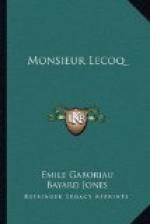While Lecoq was drawing and writing, Father Absinthe leaned over his shoulder to watch him. The plan amazed that worthy man. He had seen a great deal; but he had always supposed that it was necessary to be an engineer, an architect, or, at least, a carpenter, to execute such work. Not at all. With a tape-line with which to take some measurements, and a bit of board in place of a rule, his inexperienced colleague had soon accomplished the miracle. Father Absinthe’s respect for Lecoq was thereby greatly augmented. It is true that the worthy veteran had not noticed the explosion of the young police agent’s vanity, nor his return to his former modest demeanor. He had not observed his alarm, nor his perplexity, nor his lack of penetration.
After a few moments, Father Absinthe ceased watching his companion. He felt weary after the labors of the night, his head was burning, and he shivered and his knees trembled. Perhaps, though he was by no means sensitive, he felt the influence of the horrors that surrounded him, and which seemed more sinister than ever in the bleak light of morning. He began to ferret in the cupboards, and at last succeeded in discovering—oh, marvelous fortune!—a bottle of brandy, three parts full. He hesitated for an instant, then he poured out a glass, and drained it at a single draft.
“Will you have some?” he inquired of his companion. “It is not a very famous brand, to be sure; but it is just as good, it makes one’s blood circulate and enlivens one.”
Lecoq refused; he did not need to be enlivened. All his faculties were hard at work. He intended that, after a single perusal of his report, the investigating magistrate should say: “Let the officer who drew up this document be sent for.” It must be remembered that Lecoq’s future depended upon such an order. Accordingly, he took particular care to be brief, clear, and concise, to plainly indicate how his suspicions on the subject of the murder had been aroused, how they had increased, and how they had been confirmed. He explained by what series of deductions he had succeeded in establishing a theory which, if it was not the truth, was at least plausible enough to serve as the basis for further investigation.
Then he enumerated the articles of conviction ranged on the table before him. There were the flakes of brown wool collected upon the plank, the valuable earring, the models of the different footprints in the garden, and the Widow Chupin’s apron with its pockets turned inside out. There was also the murderer’s revolver, with two barrels discharged and three still loaded. This weapon, although not of an ornamental character, was still a specimen of highly finished workmanship. It bore the name of one Stephens, 14 Skinner Street, a well-known London gunsmith.
Lecoq felt convinced that by examining the bodies of the victims he would obtain other and perhaps very valuable information; but he did not dare venture upon such a course. Besides his own inexperience in such a matter, there was Gevrol to be thought of, and the inspector, furious at his own mistake, would not fail to declare that, by changing the attitude of the bodies, Lecoq had rendered a satisfactory examination by the physicians impossible.




